| Home |
| Home |
The Animated Cartoon Film in the Third Reich
Bearing the shining example of Walt Disney in mind, the Third Reich
launched the animated film industry in Germany. It should have become better
and bigger than Disney, but this turned out to be illusory. Too little
were the experiences of the past. It is true there were already successful
animation movies, at the head the silhouette films by Lotte Reiniger, but
an animation industry as in the USA didn't exist.
Still the German animation film in those time was able to set a
fresh impetus.
Not least because of the enthusiasm of Hitler for the animation
film, the new developing trickfilm industry could profit from generous
aid at the beginning of the Nazi time.
A diary mark of Goebbels makes Hitler's enthusiasm clear:
“I have given twelve Mickey-Mouse-movies as a present for the Führer
at Christmas! He is being pleased about it. He is absolute happy about
this treasure". (20.12.1937).
The impetus of the trickfilm began when Hitler asked himself one
day why the German Reich shouldn't be able to produces movies like Disney
too.
Till then there wasn't a real trickfilm industry in Germany, rather
there were produced decent movies in small companies. Movies with a real
story, that was out of the question.
Together with the realization of the industry it was inevitable that this market was also used for propaganda but the main part made up the pure entertainment film which had to divert from the hard times.
A lot of animation artists were ordered in whole Germany from the
Goebbelsschen propaganda machinery in the 30's and made them create a German
Walt Disney pendant in order to face up to the overpowerful "US factory"
squarely. They studied the techniques of Diseny and looked for new ways
at the same time.
The technique of the Disney studios were already partial copied
before the assumption of power happened. Already in 1931 the German animation
artists drew their figures - analogous to Walt Disney - with four instead
of five fingers, which involved an important saving of time while producing
the figures.
Along with the outbreak of World War II the movies were increasingly included for the propaganda too. The animated film "Der Störenfried - The Troublemaker" (40) by Hans Held shows, how all animals of the forest hold together in order to drive the troublemaker - a fox - away. The hedgehogs with Wehrmacht helmets and the wasps mobilized.
But Goebbels wasn't very enthusiastic about the still clumsy looking animations. He and Hitler continued to dream of Disney movies in the quality of "Snow White and the Seven Dwarfs".
A Berlin-Dahlem based animation production on a small scale was founded
in 1941 by the propaganda ministry. The leader was Luis Sehl who was especially
summoned from Rio to Germany to take on this job. The scope of duties of
this company was the production of an animation film about the mountain
ghost "Rübezahl". However this plan failed because of the insufficient
organisation and the inability of the leadership.
After this failed effort Goebbels launched the "Deutsche Zeichenfilm
GmbH" in 1942. The art direction went to Dr. Kruse. A rough draft in those
days demonstrated what kind of stuff they planned to produce in the next
few years, among others it was planned to realise the first full-length
film for the year 1947.
At the beginning of the professional animation film production the theater critic Friedrich Luft and the animators Horst von Möllendorft, E.O. Plauen (real name Erich Ohser) and Manfred Schmidt - who became famous with his figure Nick Knatterton - were recruited.
The production of the first trickfilm with the title "Armer Hansi"
was allocated to five working groups (studios), which had to do a complex
of the planned animation film in a team work with independent responsibility.
The production society even possessed an animation school and had
the ambitious plan to catch up on a lead of twenty years of the American
film industry, and this in the middle of the war.
After the conscription of Dr. Kruse for the military service, the dramaturge Frank Leberecht took over the art direction.
Because there was a need of a large number of drawers to make all the countless pictures, a lot of Poles, Frenchmen and exile Russians were taken on for payment.
The 17-minute-movie “Armer Hansi” swallowed up two years of work and set new standards, not only concerning the pictures but also because of the use of electronic music. Oskar Sala (1909) war responsible for the music, later he became famous with his filmmusic for Alfred Hitchcock's "The Birds".
Goebbels wrote into his diary:
“It is true, that the first animation film which was presented from his (Frank Leberecht) production has a lot of weaknesses, but it represents a good start”.
Because of the war terms the working groups were transfered to Munich an Vienna in 1943, where they concerned with preparations for further movies. But there weren't created more productions till the liquidation of the "Deutsche Zeichenfilm GmbH" in October 1944, so that it stopped with only one produced movie.
When Goebbels wanted to initiate the first full-length movie with
the title "Schnuff, der Niesser", 500 draftsmen worked for it. But for
Goebbels the production got on too slowly and he included a second company
- the Fischerkoesen. Later Goebbels shifted the production also abroad,
among others to Holland and Czechoslovakia.
Hans Fischerkoesen was able to make a name before this order as
a imaginative animation film maker. He didn't try to copy Disney but was
in the habit of doing his own style. He surprised with technical innovations,
among others he built in first three dimensional models into animated films.
Fischerkoesen's “Der
Schneemann - The Snowman” was one of the highlights during the time
of the National Socialists and narrated the story of a snowman who absolute
wanted to see the summer.
Fischerkoesen realised the film "Das
dumme Gänslein - The Dumb Goose" (44/45) in the last phase of
the war.
The movies of Fischerkoesen have something in common, they did without speech, only music and background sound was audible. The reason was in the first place that they wanted to sell the movies in foreign countries too without expensive synchronization.
With the end of World War II the new German animation film came also to a stop. But the draftsmen could continue their profession after the war. The animation industry was destroyed but they found occupation for the booming promotion film which especially were at its height in the 50's and 60s.
The occupation of a trickfilm drawer was very hard. They had often
to work six days a week for bad pay and they often took home some work
on Sunday to draw drafts. It wasn't unusual that overtime was unpaid. Because
most of the artists stayed in the anonymity and only a few of them were
mentioned by name they fought sometimes with the gloves off. Each was acquainted
with the other and they always knew to tell something about them.
Gerhard Fieber was born in 1916.
His passion for drawing already started in his school days where
he caricatured his teachers. He studied art and print in Berlin and worked
as a draftsman for advertising and humor for the press. In the 30's he
worked for the publicity film department of the Universum Film AG (Ufa)
and got in touch with the most important creators of promotional films.
Between 1942 and 1945 he was head drawer and art director for the Ufa subsidiary "Deutche Zeichenfilm GmbH". There he realised together with other artists the animation film "Armer Hansi - Poor Hansi" (1943). First Fieber already worked on illustrations for the Olympic Games of Berlin and for boxing matches of the legendary Max Schmeling.
Gerhard Fieber's job was to manage the German animation film to
Disney level.
He moved with the animation film studio to Dachau/Munich because
of the bombardement of Berlin.
Gerhard Fieber told in a later interview: "This was a bad time. During the working hours you were busy with trickfilm figures, at the same time you could see prisoners on the street who were harnessed in front of waggons as a replacement for horses. Nevertheless you had to draw funny figures - it was horrible".
After the war Fieber became an employee for the newfounded DEFA and presented "Purzelbaum ins Leben - Forward Roll into Life" (1946) for the East German cinemas. For the weekly show "Der Augenzeuge - The Eyewitness" of DEFA he drew the first German post-war animation object: "Der U-Bahn-Schreck - The Subway Fright". Beside it he also drew promotion films for the SED.
Fieber founded the EOS Film Production in Bad Sachsa in 1948 which
grew into the biggest German animation studio during the years of economic
miracle. With "Tobias Knopp, Abenteuer eines Junggesellen" - after a book
by Wilhelm Busch - he realised in 1949 the first full-lenght animation
film ot the post-war time. The voices were spoken by well-known German
actors like Erich Ponto, Günter Lüders, Grethe Weiser and René
Deltgen.
The EOS film production concentrated on the up-and-coming promotion
film. Fieber created works for authorities, labor unions, parties and economic
companies.
Gerhard Fieber attended to television in the 60's with the rise
of this medium and got several awards (among others the "Filmband in Gold").
A cooperation with Franz Thies (Neue Filmproduktion Wiesbaden) started and offered Gerhard Fieber those animation works, which are still "alive" and extreme popular - "Die Mainzelmännchen" (by Creator Wolf Gerlach).
Gerhard Fieber belonged to "the last Mohicans" from a time where
animation films were completely produced by hand.
His creativity and his ideas were unbroken till to his old age.
On January 6, 2013 he died at the age of 96.
Gerhard Fieber drew for me the lovely bitch "Tina" in 1998.
A filmic biography can be seen on youtube.
Heinz Tischmeyer was born in 1913.
He started his training as an animation artist at the age of
16 at the trickfilm studio Waechter in Berlin, where he worked between
1928 and 1931. Likewise he designed humorous promotion animation films
since 1928 and learnt the making of technical animation films for industrial
companies. At evening class he attended the academy of arts for letter
and commercial art in Berlin.
From 1931 to 1933 he was worked as an animation artist for the trickfilm studio Pál in Berlin. This production endeavoured to adapt the American style of drawings. The company was liquidated in 1933 as a result of the political transition of power in Germany.
Because of his acquired specialized knowledge he got a job at
the same year at the Ufa animation film studio, which was the most important
promotion film enterprise in Germany in this time and produced sound movies
since 1929 and color films since 1932. Tischmeyers scope of duties comprised
the design of complete movies in his own drawing style and the making of
promotion films.
He interrupted his working relation for the Ufa in 1934 and emigrated
to Switzerland because he didn't want to stay in a National Socialist Germany.
He hoped for a job for the film production "Pnschewer" in Bern, but the
company itself emigrated briefly before that from Berlin to Switzerland.
Therefore the company had financial difficulties at the beginning and a
new contract wasn't signed. Therefore Heinz Tischmeyer was forced to come
back to Germany and to take up his activity for the Ufa. He closed his
activity for the Ufa in 1936.
After his voluntary retirement from the Ufa trickfilm studio he founded his own trickfilm studio where he worked self-employed for different companies from 1936 to 1942. His clientele comprised the Schongerfilm Berlin for youth and children fairy tales, the Kinomatfilm Wuppertal for promotion animation films and the Bayer I.G. Farben Leverkusen for medical technological animation films.
Heinz Tischmeyer drew among others the color film "Vom Bäumlein, das andere Blätter hat gewollt" (1940) and the fairyfilm "Die Bremer Stadtmusikanten" (43) . It narrates the story of a conifer which longs for leafs. Finally the tree stays proud with golden leafs in the forest. But then a thief approaches who steals the leafs. The fairy tale was written by the German poet Friedrich Rüchert (1788-1866) and the film was provided with his original text.
The "Deutsche Zeichenfilm GmbH was founded in Berlin in 1942. Because of his well-known name in the line of business, Heinz Tischmeyer was engaged for assistance. For the first film of this company called "Armer Hansi - Poor Hansi", one of the five groups was entrusted to Heinz Tischmeyer.
Heinz Tischmeyer was engaged for a state-owned film department in Berlin in 1944 in the course of the declaration of total war of the NS regime. But till the end of the war he wasn't active in this department.
In the years of 1945 and 1946 there was a pause in the creative power of Heinz Tischmeyer because of the collapse of the old Germany and the reorganization of the new Germany.
He founded a trickfilm studio for the "Schonger Jugendfilm" production in Tutzing in 1947. In a one-year work, under the difficult post-war conditions, he created together with ten employees the first chrildren's film in Germany after the war. At the same time he also worked for the Bavariafilm GmbH in Munich Geiselgasteing for feature film productions. He drew titles and animation effects for different movies, among others "Der Apfel ist ab" (1948), directed by the famous Helmut Käutner (1908-1980) and "Der Herr vom andern Stern" (1948), with the legendary Heinz Rühmann (1902-1994). This additional job he carried on till 1952.
Afterwards it followed an engagement for the Fischerkoesen-Filmstudio
in Bonn-Bad Godesberg. This studio was the best-known and most successful
promotion film company in Germany at this time. Heinz Tischmeyer led a
staff in the function of a main drawer. The motion-picture promotion film
and also the TV commercial spot had a boom during the economic recovery
in the 50's and 60's. Therefore the creation of Heinz Tischmeyer was connected
with interesting jobs. During his occupation for Fischer-Koesen he could
design the movies in his own style. Well-known companies like Coca Cola,
Trumpf-Schokolade, Mülhen's 4711 and BP belonged to the customers
of the film production.
Some of Heinz Tischmeyer's drown promotion films were honored
at different film festivals. But because it wasn't usual to name the doers
of these films, the awards went to the production company Fischerkoesen.
The birth of TV involved a multitude of new challenges. It was necessary to separate the commercial spots plain, because they were televised one after another in a high speed. This led to a lot of commercial television figures which appeared between the spots. The first of these figures was conceived by Hans Fischerkoesen and Heinz Tischmeyer in 1957. It showed a seal for the "Hessischer Rundfunk". Shortly afterwards the viewers gave it the nickname Unclo Otto. Till today a lot of the Uncle Otto fade ins "drown by Heinz Tischmeyer) are still used today, with which the seal belongs at the "age of 44" to the oldest still active commercial television figures.
The production of promotion films had to be shut down because of internal economical differences. This resulted in the liquidation of the studio.
After that Heinz Tischmeyer got an engagement as an animator for
the "Neue-Filmproduktion" in Frankfurt where he worked for the "Mainzel-Männchen.
There he worked as an employee between 1971 and 1978, and from 1979 to
1990 he worked as a freelancer. The making of scripts and the design of
"Mainzel-Männchen" spots were part of his job.
For the Bremer commercial television he created the "Bremer Stadtmusikanten".
For the ZDF serials "Ein verrücktes Paar" and "Drei Damen vom Grill" he created cartoons for the title and credits which was novel at this time and met with great enthusiasm.
He closed his professional life in 1990 but his interest in the trade is still alive.
Along with the animation he devoted to press drawings for the daily "BZ am Mittag" and "Berliner Lokalanzeiger" since the beginning of the 30's. There he created humorous illustrations for newspaper articles, theater and film premiere as well as drawings for the funny columns (see below). He didn't draw political caricatures becaise it was his principle no one to offend with his drawings. His portrait caricatures of actors were always shown friendly (see below).
Heinz Tischmeyer has kindly sent me an original drawing for a perfume advertising from 1963 for my collection. Moreover he let me have some copies of his caricatures from the 30's and 40's for the gallery below.
 |
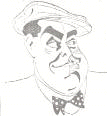 |
 |
 |
 |
 |
 |
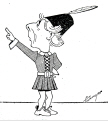 |
 |
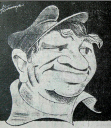 |
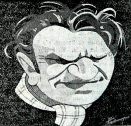 |
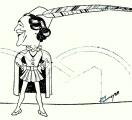 |
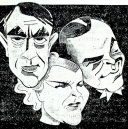 |
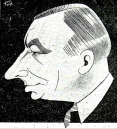 |
 |
 |
 |
 |
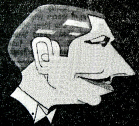 |
 |
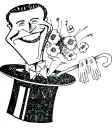 |
 |
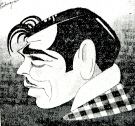 |
 |
| With click on the caricatures you will get an enlargement! A thank goes to Mr. Tischmeyer to provide with these portraits. |
On behalf of all the countless anonymous drawers I introduce the
animation drawer Anna-Luise Subatzus.
She was born in 1913 in Hamburg. During World War II she worked
for the Deutsche Zeichenfilm GmbH and experienced the move to Dachau after
the bomb attacks on Berlin, where she was accomodated in the artist home
Moosschweige and continued her work for the animated film.
After the war she returned to her home town Detmold where she worked as a translator for the English military government. There she met an English officer; in 1947 she gave birth to her daughter Gabriele. The father abandoned the young family soon because he was completely unsuitable for the marriage.
Anna-Luise Subatzus returned to the animated film scene in 1949 and
worked for the EOS-Film-Production for the movie "Tobias Knopp, Abenteuer
eines Junggesellen". It was her only work she was mentioned by name in
the credits.
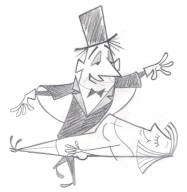
In 1950 she went to the Schonger-Film in Munich, two years later
she worked at Fischerkoesen in Mehlem. During this labour-intensive time,
when she had to work for Fischerkoesen from early to late, it wasn't possible
for her to look after her daughter and gave her to Gabriele's uncle and
aunt for care.
In 1960 Anna-Luise Subatzus went to Düsseldorf to draw promotional trick films for the Ufa. Shortly afterwards she changed to Gerhard Fiebers EOS-Film in Göttingen where she worked several years. She found her last working station at the geological institute of Göttingen, where she did finest drawings of fossils for scientific publications.
During her long career she developed many ideas and drafts which
also were used; but a mention by name was normally refused - a destiny
she shared with many other colleagues.
Anna-Luise Subatzus didn't become rich with her work. During her
time at Fischerkoesen for example she could only afford a room of 12 m2
for her daughter and herself. She didn't get much from the economic miracle.
Anna-Luise Subatzus died in 1994 in Bremen.
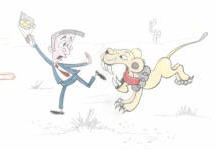 |
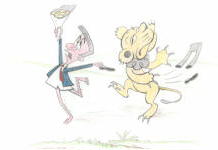 |
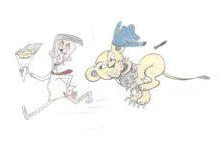 |
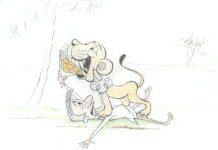 |
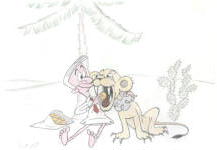 |
| Original draft by Anna-Luise Subatzus |
A special thank goes to Mr. Heinz Tischmeyer and Mrs. Gabriele Brejla who assisted with effective help for the résumé of this article.